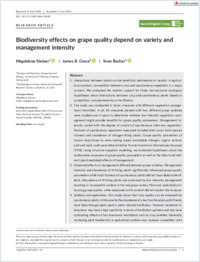Biodiversity effects on grape quality depend on variety and management intensity
- Steiner, Magdalena Ecology and Evolution, Department of Biology, University of Fribourg, Fribourg, Switzerland
- Grace, James B. US Geological Survey, Wetland and Aquatic Research Center, Lafayette, LA, USA
- Bacher, Sven Ecology and Evolution, Department of Biology, University of Fribourg, Fribourg, Switzerland
-
2021
Published in:
- Journal of Applied Ecology. - 2021, p. 1-13
Ecology
Competition
Complementarity
Ecological intensification
Facilitation
Grape quality
N-fixing plants
Spontaneous vegetation
Vineyards
English
1. Interactions between plants can be beneficial, detrimental or neutral. In agricultural systems, competition between crop and spontaneous vegetation is a major concern. We evaluated the relative support for three non-exclusive ecological hypotheses about interactions between crop and spontaneous plants based on competition, complementarity or facilitation. 2. The study was conducted in Swiss vineyards with different vegetation management intensities. In all, 33 vineyards planted with two different grape varieties were studied over 3 years to determine whether low-intensity vegetation management might provide benefits for grape quality parameters. Management intensity varied with the degree of control of spontaneous inter-row vegetation. Features of spontaneous vegetation measured included total cover, total species richness and abundance of nitrogen-fixing plants. Grape quality parameters of known importance to wine making (yeast assimilable nitrogen, sugars, tartaric acid and malic acid) were determined by Fourier-transform infrared spectroscopy (FTIR). Using structural equation modelling, we evaluated hypotheses about the multivariate responses of grape quality parameters as well as the direct and indirect (plant- mediated) effects of management. 3. Observed effects of management differed between grape varieties. Management intensity and abundance of N-fixing plants significantly influenced grape quality parameters while total richness of spontaneous plants did not have detectable effects. Abundance of N-fixing plants was enhanced by low-intensity management resulting in increased N content in the red grape variety Pinot noir, potentially enhancing grape quality, while measured soil N content did not explain the increase. 4. Synthesis and applications. Our study shows that crop quality can be enhanced by spontaneous plants, in this case by the abundance of a key functional group (N-fixers), most likely through plant–plant or plant–microbe facilitation. However, beneficial interactions may have a high specificity in terms of facilitation partners and may have contrasting effects at low taxonomic resolutions such as crop varieties. Generally, increasing plant biodiversity in agricultural systems may increase competition with crops. Thus, the identification of suitable interaction partners and a careful balance between crop variety and spontaneous plant species may be necessary to utilize beneficial interactions and to reduce the trade-off between agricultural production and biodiversity to achieve a sustainable ecological benefit in agricultural systems.
- Faculty
- Faculté des sciences et de médecine
- Department
- Département de Biologie
- Language
-
- English
- Classification
- Biological sciences
- License
- License undefined
- Identifiers
-
- RERO DOC 330478
- DOI 10.1111/1365-2664.13899
- Persistent URL
- https://folia.unifr.ch/unifr/documents/309412
Statistics
Document views: 128
File downloads:
- bacher_et_al_2021_biodiversity.pdf: 267
